|
|
|
|
|
Yeou Chih YCC-63F1 Server Case |
|
Join the community - in the OCAU Forums!
|
Side Vent, Usage, Conclusions
The side vent, which is configured as an intake, is a bit of a misfeature in my opinion. When combined with the CPU duct going to the rear exhaust fan and the CPU fan set to blow air up off the heatsink it would definitely ensure a constant flow of ambient air into the motherboard area, through the CPU heatsink and out the rear of the case. However, there is no dust filter on this intake fan, only an odd hexagonal grille. The raised plastic mounting around this intake is bizarre and really spoils the look of the case. As far as I can tell, it exists only to give the fan-mounting screws (which are screwed on from the inside) something to grip and to support the hex-pattern fan grille. Surely a standard wire fan grille, or even just some vent holes cut into the side panel, with the fan screws going from the outside of the case into the fan body, would achieve the same effect while looking a lot better. This protruding duct also means you can fit less of these cases side-by-side in a given space, which would be a concern for people using these as servers in a datacentre.
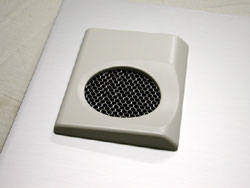 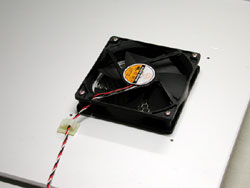
Usage:
Installing components into this case presented no problems at all. It's very roomy inside and most, but not all, metal edges are rolled so they aren't sharp. I used ABIT's IC7 motherboard, a PowerColor Radeon 9800 Pro and a few other goodies. Actually, this case has been used for testing some other components and has also served as my gaming machine for the last few weeks. It's nice to work with, although it does take up some room on your desk.
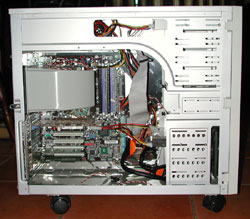
Here's a photo showing the size of this case relative to a normal ATX minitower, the COMSCOM Think Tank we reviewed not long ago. The Think Tank is quite deep for a minitower, due to its front-mounted hard drive bays. The YCC-63F1 is another inch or so deeper, and noticeably wider and taller - even without the wheels installed. However, it's surprisingly light for such a big case, thanks to the aluminium construction.
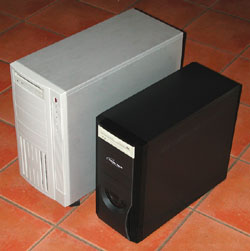
The power LED is one of the ultra-bright blue ones we're so used to seeing now. I was a little disappointed by this. It seems that this whole case has been designed primarily around function, with not even a nod towards the trend to "bling" up PC cases with glowing bits and fancy decoration. Then, in what seems like an after-thought, a bright blue LED is used to indicate power. It seems a bit out of place to me. The other two LEDs are green.
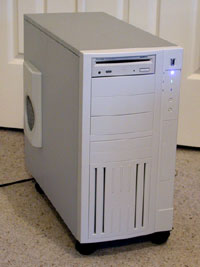
With the three included fans running, the case does produce a fair bit of noise, not a huge amount, but there's a clearly audible humming when the box is in operation. While the noise is noticeable, at least it's not an annoying high-pitched tearing sound like some fans produce. I actually ignored the noise for a long time, but when I turned the PC off I realised just how much background noise it had been producing. It seems the three 120mm fans are not low-noise, low-speed models, although they do have 3-pin connectors so you can monitor and control their speed via a fanbus or certain motherboards.
If your purpose for this case is to build a high-powered workstation or server with lots of drives and perhaps several CPUs, then you'll be happy that the fans move a fair bit of air, regardless of the noise. If you're aiming to build a silent PC around this case, you will need to replace the fans or leave some of them unplugged. Again, it's not unbearable, but it's not quiet either.
Conclusions:
Overall, I think the YCC-63F1 is a pretty good case. It's certainly easy to work with, being sturdily constructed with plenty of room inside. It's attractive enough, in an old-school kind of way, and it stands up well feature-wise next to more fancily decorated cases. From an air cooling perspective it fares very well in stock form, but with it's large internal area, wheels for easy transport and 3x120mm fan mounts it would also be worth considering for a watercooling project. If you're after a roomy case that doesn't sacrifice features for pretty lights, the YCC-63F1 is definitely worth a second look.
Thanks to YCC for providing the review sample. Their cases are distributed in Australia by Weston Technology, who were unable to provide pricing information at this time.
|
|
Advertisement:
All original content copyright James Rolfe.
All rights reserved. No reproduction allowed without written permission.
Interested in advertising on OCAU? Contact us for info.
|

|


